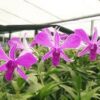# History and Development of Dendrobium Orchids in Vietnam

Dendrobium orchids, with their exquisite beauty and diverse species, hold a significant place in Vietnam’s horticultural landscape. Known for their vibrant colors and long-lasting blooms, these orchids have become a symbol of beauty and elegance. This article delves into the history and development of Dendrobium orchids in Vietnam, exploring their cultural significance, the evolution of cultivation techniques, and their impact on the local economy and biodiversity.
## Table of Contents
1. **Origins of Dendrobium Orchids**
– 1.1 Taxonomy and Classification
– 1.2 Geographic Distribution
2. **Historical Significance of Dendrobium in Vietnam**
– 2.1 Traditional Uses
– 2.2 Cultural Symbolism
3. **Development of Orchid Cultivation in Vietnam**
– 3.1 Early Cultivation Practices
– 3.2 Advances in Cultivation Techniques
– 3.3 Role of Research Institutions
4. **Dendrobium Orchids in Vietnamese Horticulture**
– 4.1 Commercial Production
– 4.2 Export Market
– 4.3 Local Varieties and Hybrids
5. **Challenges in Dendrobium Cultivation**
– 5.1 Environmental Factors
– 5.2 Pests and Diseases
– 5.3 Climate Change Impact
6. **Conservation Efforts**
– 6.1 Protecting Native Species
– 6.2 Sustainable Practices in Cultivation
7. **Future Prospects for Dendrobium Orchids in Vietnam**
– 7.1 Innovations in Orchid Cultivation
– 7.2 Global Trends and Opportunities
8. **Conclusion**
– 8.1 Summary of Key Points
– 8.2 The Importance of Dendrobium Orchids in Vietnamese Culture
—
## 1. Origins of Dendrobium Orchids
### 1.1 Taxonomy and Classification
The genus Dendrobium belongs to the family Orchidaceae, encompassing over 1,800 species found in various tropical and subtropical regions. Dendrobium orchids are characterized by their pseudobulbs, elongated stems, and numerous flowers. They exhibit a wide range of forms, colors, and sizes, making them a popular choice among orchid enthusiasts.
### 1.2 Geographic Distribution
Dendrobium orchids thrive in a variety of environments, from rainforests to mountainous regions. In Vietnam, they are predominantly found in the northern and central highlands, where the climate and altitude create favorable conditions for their growth. The country’s rich biodiversity and varied topography contribute to the unique characteristics of its Dendrobium species.
## 2. Historical Significance of Dendrobium in Vietnam
### 2.1 Traditional Uses
In Vietnamese culture, orchids, including Dendrobiums, have long been associated with elegance and refinement. Historically, they were used in traditional medicine for their purported health benefits, such as treating respiratory ailments and boosting immunity. Dendrobium stems and leaves were often incorporated into herbal remedies, highlighting the plant’s significance in local healing practices.
### 2.2 Cultural Symbolism
Dendrobium orchids are considered symbols of beauty and prosperity in Vietnam. They are frequently used in traditional ceremonies, including weddings and festivals. The elegant blooms are believed to bring good luck and are often given as gifts to express love and appreciation. Their cultural significance is deeply rooted in Vietnamese traditions, making them a beloved floral choice for various occasions.
## 3. Development of Orchid Cultivation in Vietnam
### 3.1 Early Cultivation Practices
The cultivation of orchids in Vietnam can be traced back several centuries. Traditional methods involved growing orchids in natural settings, such as trees or rocks, mimicking their natural habitat. Early cultivators relied on their knowledge of local environmental conditions and plant behaviors to nurture these beautiful flowers.
### 3.2 Advances in Cultivation Techniques
In recent decades, advancements in horticultural practices have revolutionized Dendrobium cultivation in Vietnam. Growers have adopted modern techniques, including tissue culture and hybridization, to enhance the quality and quantity of blooms. These innovations have led to the development of new varieties with improved disease resistance and longer-lasting flowers.
### 3.3 Role of Research Institutions
Research institutions, such as the Agricultural Genetics Institute and the Vietnam National University of Agriculture, have played a pivotal role in the advancement of orchid cultivation in Vietnam. These institutions focus on researching native species, developing improved cultivation methods, and promoting sustainable practices among local growers.
## 4. Dendrobium Orchids in Vietnamese Horticulture
### 4.1 Commercial Production
Dendrobium orchids have become a significant crop in Vietnam’s horticultural industry. The country is now recognized as one of the leading producers of Dendrobium orchids in Southeast Asia. Commercial growers supply local markets and export their products to international buyers, contributing to the country’s economy.
### 4.2 Export Market
The export of Dendrobium orchids has seen significant growth, with countries like the United States, Japan, and South Korea being major importers. The unique characteristics of Vietnamese Dendrobium varieties, combined with competitive pricing, have positioned Vietnam as a key player in the global orchid market.
### 4.3 Local Varieties and Hybrids
Vietnam is home to several native Dendrobium species, including Dendrobium anosmum, Dendrobium nobile, and Dendrobium spectabile. Local growers have successfully hybridized these species, resulting in new varieties that showcase vibrant colors and unique shapes. These hybrids have gained popularity both domestically and internationally, further enhancing the reputation of Vietnamese orchids.
## 5. Challenges in Dendrobium Cultivation
### 5.1 Environmental Factors
While Vietnam’s climate is generally favorable for orchid cultivation, environmental factors such as drought and excessive rainfall can pose challenges. Growers must carefully monitor weather conditions and adjust their cultivation practices accordingly to ensure the health of their orchids.
### 5.2 Pests and Diseases
Pests, including aphids, mealybugs, and spider mites, can significantly impact Dendrobium orchids. Additionally, diseases such as root rot and fungal infections are common threats. Implementing effective pest management strategies and maintaining proper hygiene in growing environments are essential for minimizing these risks.
### 5.3 Climate Change Impact
Climate change poses a significant threat to Dendrobium cultivation in Vietnam. Rising temperatures and unpredictable weather patterns can disrupt traditional growing practices and affect the overall health of the plants. Growers must adapt to these changes by adopting sustainable practices and selecting resilient orchid varieties.
## 6. Conservation Efforts
### 6.1 Protecting Native Species
With the increasing popularity of Dendrobium orchids, there is a growing concern about the conservation of native species. Several organizations and institutions in Vietnam are working to protect these valuable plants by promoting sustainable harvesting practices and habitat conservation.
### 6.2 Sustainable Practices in Cultivation
Sustainable cultivation practices are crucial for preserving Vietnam’s orchid biodiversity. Educating growers on eco-friendly methods, such as organic fertilization and integrated pest management, helps reduce the environmental impact of orchid production while maintaining high-quality blooms.
## 7. Future Prospects for Dendrobium Orchids in Vietnam
### 7.1 Innovations in Orchid Cultivation
The future of Dendrobium cultivation in Vietnam looks promising, with ongoing research and innovations in cultivation techniques. Advancements in biotechnology and genetic research are expected to lead to the development of new varieties with enhanced qualities, including improved disease resistance and increased adaptability to changing environmental conditions.
### 7.2 Global Trends and Opportunities
As global demand for orchids continues to rise, Vietnam is well-positioned to capitalize on this trend. By focusing on sustainable practices, improving the quality of their products, and expanding their marketing efforts, Vietnamese growers can strengthen their presence in the international orchid market.
## 8. Conclusion
### 8.1 Summary of Key Points
The history and development of Dendrobium orchids in Vietnam are intertwined with the country’s cultural heritage, horticultural advancements, and economic growth. From their traditional uses to modern cultivation techniques, Dendrobium orchids have become a symbol of beauty and resilience in Vietnamese society.
### 8.2 The Importance of Dendrobium Orchids in Vietnamese Culture
As Vietnam continues to embrace its rich floral heritage, the future of Dendrobium orchids looks bright. Their significance in local culture, combined with ongoing research and sustainable practices, will ensure that these stunning flowers remain a cherished part of Vietnam’s natural and cultural landscape for generations to come. The journey of Dendrobium orchids in Vietnam reflects the harmony between nature and human creativity, showcasing the enduring beauty of these remarkable plants.

